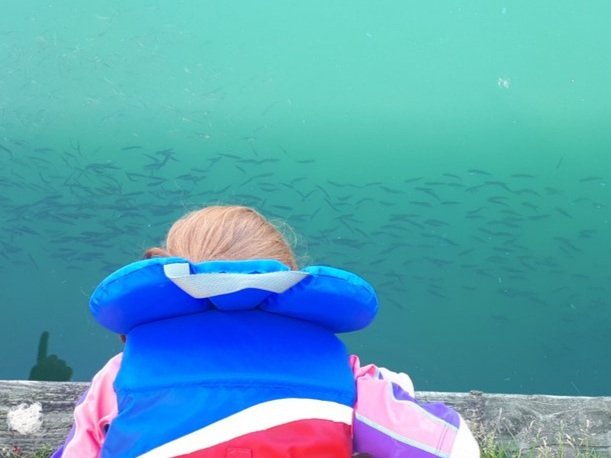Forage Fish: The Energy of the Salish Sea
by Aby Elwood, Educator
School of Pacific herring. Photo: Tina Kelly
Did you know that small, pelagic, schooling fishes, such as Pacific herring, are some of the most important animals found in the Salish Sea? I like to think of them as an energy source for the Salish Sea ecosystem. They get their name from being a key food source for so many marine creatures. Come along with me and learn more about the small, silvery sources of sustenance in the Salish Sea. (Say that ten times fast!)
What is a forage fish?
Forage fish, also known as prey or bait fish, is a term used to describe aquatic species that are an important and nutritious food source for a variety of upper-level predators. These fishes are generally silver in colour, very small in size, and travel in large schools in the pelagic zone of the ocean. Some local forage fishes are Pacific herring, Pacific sand lance, northern anchovy, and surf smelt. The term “forage fish”, however, does not only apply to true fish species. Other animals such as squid and shrimp are considered forage fish, as they also play a significant role of prey for many ocean predators.
Cormorant. Photo: Bob Orchard
Why are forage fish important?
Ocean animals are all connected by predator-prey interactions and this creates the food web. Forage fish are a key component of the marine food web because they are prey to many different animals like whales, pinnipeds (seals and sea lions), salmon, seabirds, and more. Forage fish transfer the energy they obtain from eating plankton to the upper level predators .
In the Salish Sea, forage fish are important prey for Chinook salmon. Without them, Chinook salmon populations are at risk of further decline, resulting in less food available for Chinook lovers including the endangered Southern resident killer whales. Abundance of forage fish is critical for maintaining healthy ecosystems and without them, negative effects will cascade through the food web.
Not only do animals rely on forage fishes, but humans do too. Forage fish are extremely important to Indigenous communities. They eat the fish as well as the eggs that are deposited in coastal habitats. Coast Salish peoples depend heavily on salmon as a part of their diet and culture.
Spawning!
Herring, sand lance, surf smelt, and other forage fishes rely on shallow, coastal habitats for spawning. Surf smelt and Pacific sand lance spawn in the intertidal zone of sandy beaches, primarily in areas with overhanging vegetation where the shade protects the eggs from the sun. There is uncertainty surrounding Northern anchovy spawning locations, but observations suggest they move into coastal bays and inlets to spawn.
Pacific herring move into intertidal and subtidal zones to spawn, laying their eggs on eelgrass, seaweeds, and other structures to await fertilization. This species is known for creating quite the spectacle during their spawning season as the male herring’s milt turns the water a beautiful turquoise colour and the abundance of fish draws in a variety of predators looking for a snack. The peak spawning season is different for each species, and also depends on the latitude/location. Here in the Salish Sea, some forage fish spawn in winter months (surf smelt and sand lance), and others spawn in the early spring (herring and anchovy).
Pacific herring eggs on sea lettuce. Photo: Tina Kelly
School of Pacific herring. Photo: Jackie Hildering, The Marine Detective
Threats to forage fish
Natural fluctuations in numbers of forage fish are common. Abundances of forage fishes can change each year due to natural occurrences and environmental changes. However, forage fish abundance can be and has been heavily impacted by a variety of unnatural factors. Overfishing is a common threat to forage fish. They are sought out as fish meal or bait and often overharvested. Another factor leading to a decrease in abundances is climate change. Changes in climate affect the food availability and reproductive success of forage fish. Urbanization and human development along shorelines is decreasing the water quality and sediment availability needed to produce successful offspring. This ultimately leads to habitat degradation and a decline in available spawning grounds. Overall, anthropogenic activity is having a negative impact on forage fish abundances, which not only impacts the species of fish themselves but also the plethora of animals that rely on them.
There you have it! A little dive into the understanding of forage fish, their impact on our oceans, and our impact on them.
To learn more about Pacific herring:
-Visit our newest display on Pacific herring
-Read The Marine Detective’s blog Marine Murmuration – Pacific Herring




